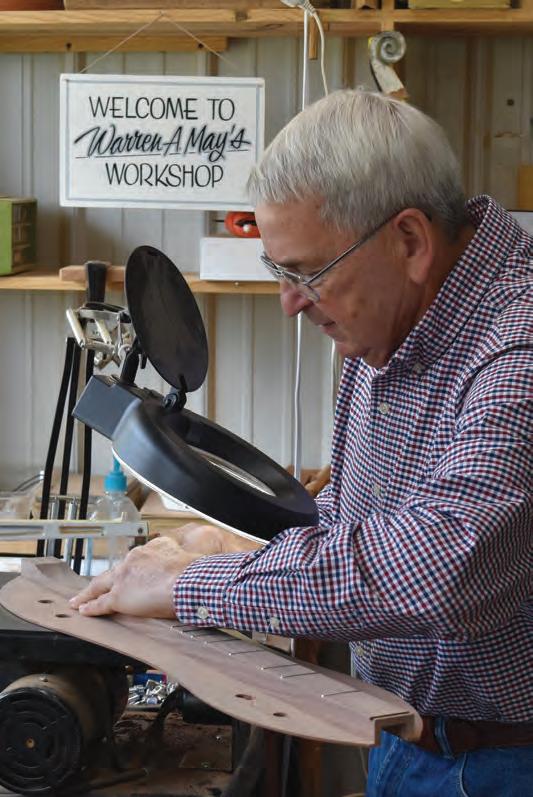
6 minute read
For the Love of the Craft
Warren May’s dulcimers honor the wood and the music
Text and Photos by Kim Kobersmith
Anecessary component of a Warren A. May dulcimer is time.
The first element is wood, and its story began many decades ago. It started as a tiny seed, then flourished as a walnut tree on a remote Kentucky farm. After withstanding storms, predators and other ravages of time, the tree was marked by those hardships in the distinct beauty of its grain pattern. At the end of its life, the tree was collected by May. He then gave it time, letting it mellow and age in his workshop for more than 30 years.
“The tone and look of the vintage wood is better,” he said.
One day, May pulled out that piece of walnut and cut it into slabs. He studied the piece of aged wood, getting to know its knots, its grain and its particularities. Only then did he take his template and cut a halfdulcimer shape from it. He cut that shape into six thin pieces, each of which would become half of the front or back of one of his artisan instruments.
“The wood selection and placement are important for the tone,” said May, who lives in Berea.
Those 1/8-inchthick panels are seasoned for months before May begins the three-week process of turning them into an instrument. Each front and back is book-matched, which means he takes neighboring pieces of wood, splits them open like a book, and crafts a whole top or bottom from them. In this way, he highlights the unique character of each piece of wood and honors the history and beauty of the tree from which it came.
May uses a combination of handwork and machine work to craft his dulcimers. The sound holes, cut on a scroll saw, become hummingbirds, vines and enhanced knotholes. The fretboards are marked with wood-burned tulips, and the end scrolls are hand-carved. Completed

dulcimers are hand-finished to a gleam.
He saves his finest wood and most elaborate handwork for his Ultimate models. Each is crafted from aged walnut or cherry or exotic tonal woods like Brazilian cherry. The fretboards are wood-burned with intricate flowering vines and inlaid with turquoise.
They are beautiful enough to hang on a living room wall as works of art. But that is not May’s intent. “I make my dulcimers for people,” he said. He wants them to be

played, for them to come alive and bring joy to their owners, no matter if they play folk or classical music.
May is one of the last makers of the traditional style of Kentucky dulcimers, the official state instrument. Dulcimers have been an integral part of mountain culture since the 1700s, when they migrated to Appalachia with German immigrants. Easy to make and easy to play, these simple fretted instruments were quickly adopted in a region known for its a cappella singing.
While the instrument is three-stringed, only the single melody string needs to be fingered. But magically, each strum reveals a perfect three-part harmony. May explained that, by eliminating all sharps and flats, the strings become perfectly complementary. Given that a dulcimer player can perform chords and the melody together—a
may sells his traditional handcrafted dulcimers via mail order through Facebook and his website, warrenamay.com.

rare feat for string instruments—it is the perfect accompaniment for regional ballad music.
May started making dulcimers in 1972. While they have a traditional design, his dulcimers have small modifications to enhance the musicality and ease of playing. Lighter colored wood is placed on the top of the instrument, lending its rich, resounding tone. He adds a fourth string—a double melody string—for a stronger lead line.
Most of May’s dulcimers are crafted from native central Kentucky woods: walnut, cherry and tulip poplar. Each has a distinctive tone and look. Poplar is lighter yellow-green and has an authentic ringing sound. Walnut is brown and sounds mellow and forgiving. The reddish cherry has a more precise noting quality.
More than half of the wood he uses is vintage and harvested from 30-50 years ago, which gives it a richer tone and patina. May pointed out one particularly striking

instrument, crafted from 50-year-old curly cherry. It seemed to sparkle as the light danced across the surface. And this artful selection of wood was on the back of the dulcimer.
May typically does not use recycled wood, with a few exceptions. In his collection, he has a stash of particularly beautiful 100-year-old poplar from a Casey County jail. He also has some wood from the 1800s log cabin where he was born and grew up as the youngest of 10 children in Carroll County. A lifelong Kentuckian, May graduated from Eastern Kentucky University. He worked as a shop teacher for eight years before devoting his life to woodworking. He discovered dulcimers while teaching in Lawrence County, a stop on the Country Music Highway that is steeped in musical tradition. “I tried to play the guitar,” he said. “I was not much good at it.”
His business benefited from two other Kentuckians who popularized the dulcimer. One was Jean Ritchie from
Viper, who was part of the American folk music revival in the 1950s and ’60s. She introduced folk music greats, such as Pete Seeger and Woody Guthrie, to the mountain dulcimer and launched its mainstream popularity.
The other was the late Phyllis George. As the First Lady of Kentucky in the early 1980s, she promoted the exquisite arts and crafts of the Commonwealth. George had a deep appreciation for May’s work.
May is an internationally acclaimed dulcimer maker. He was an exhibiting member of the Kentucky Guild of Artists and Craftsmen and has lifetime juried status with the Kentucky Crafted Program. But when asked about any famous people who have his instruments, he steers the conversation toward homegrown musicians.
The subtle tones of the mellow dulcimer do not make the instrument ideal for stage performances. But May delights in making the practical, easyto-play instruments that can be enjoyed at home or in small gatherings. In July, one of his newly completed works was headed out to a 94-year-old gentleman who had recently decided to start playing the dulcimer.
2020 marks the end of an era for May. When he became a full-time woodworker, he and his wife, Frankye, moved to Berea, the arts and crafts capital of Kentucky. For 42 years, they had a dulcimer shop on College Square, open six days a week, which was a cornerstone of the local craft scene. They closed their storefront last December.
May is enjoying the increased freedom that being semi-retired allows and paying more attention to the work on his 47-acre farm, but he continues with his life’s work of crafting dulcimers. He signs, dates and numbers each instrument. On a visit to his studio in July, he was in the midst of making instrument number 18,907. That is more than one instrument a day for the 48 years of his dulcimer-making career, a lifetime composition of sweet music. Q
2020 Season sponsored by
Now Open!

NEW SLOTH EXHIBIT
Get up. Get out. Get to the Zoo. LouisvilleZoo.org






